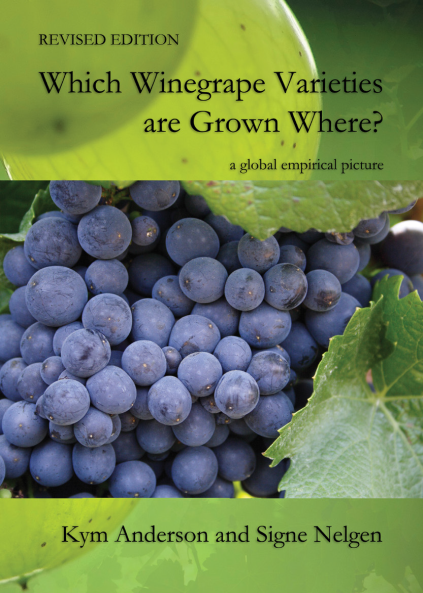Which Winegrape Varieties are Grown Where?

(Revised Edition)
by Kym Anderson and Signe Nelgen
An update and expansion of the 1st edition by Kym Anderson (with the assistance of N.R. Aryal)
FREE | 2020 | Ebook (PDF) | 978-1-925261-86-8 | 800 pp
FREE | 2013 | Ebook (PDF) | 978-1-922064-68-4 | 690 pp
The January 2015 Newsletter of the international wine writer Jancis Robinson.
'José [Vouillamoz] made a fascinating graphic out of Kym Anderson of the University of Adelaide's table of the world's most planted grape varieties. This showed that the fastest growing varieties have been Syrah, Cabernet Sauvignon, Merlot and Tempranillo. He suggested that it would be a good thing for the Chinese to wean themselves off Cabernet and on to Tempranillo because it ripens so usefully early for a country where temperatures plummet quite early in autumn.'
Jancis Robinson, international wine writer, 23 May 2014 at the Masters of Wine symposium in Florence.
'One of the most extraordinary wine publications of last year ... an unexpected post-Christmas gift for grape geeks.'
Max Allen, The Australian, 4 January 2014.
‘In an increasingly interconnected world wine market, evolving consumer demands, technologies, and climate have all contributed to large shifts in global patterns of production and consumption of wine. These shifting patterns of wine production and consumption have entailed changes in the vineyard in terms of total area planted, production practices, and the mix of grape varieties grown. In this book, for the first time, we have a detailed empirical picture, country by country and region by region within countries, of which varieties of grapes have been grown where, and how those varietal choices have changed over time. This statistical compendium will be directly useful for anyone interested in knowing about and understanding the changing patterns of production of wine and wine grapes around the world. It also will serve as an invaluable resource for economists and others who seek to analyze those patterns and their causes.’
Professor Julian Alston, Director of the Robert Mondavi Institute’s Center for Wine Economics, University of California, Davis.
‘This new database charts exactly what varieties are grown in which regions around the world. Since the data sets are based on two broad census periods, in 2000 and 2010, readers can also follow major planting trends around the world during the first decade of this new century. This colossal trawl makes it the perfect complement to the 2012 publication of Wine Grapes by Jancis Robinson, Julia Harding and José Vouillamoz.’ (Jefford on Monday: The Great Grape Census, 09 Dec 2013)
Andrew Jefford is a wine writer for Decanter and The World of Fine Wine, and author of The New France.
‘Kym Anderson is a pioneer in the study of the economics of wine, and this book contains the raw materials for others to do the same kind of extraordinary research.’
Professor Orley Ashenfelter, Princeton University, former President of the American Economic Association and former Editor of the American Economic Review, and founder/author/publisher of the newsletter Liquid Assets.
The database on which this book draws is freely available in Excel at https://economics.adelaide.edu.au/wine-economics/databases
About the authors
Kym Anderson is George Gollin Professor Emeritus of Economics at the University of Adelaide and founding Executive Director of its Wine Economics Research Centre. He is also an Honorary Professor at the Australian National University’s Crawford School of Public Policy, and Vice-President of the American Association of Wine Economists and Co-Editor of its Journal of Wine Economics. He has worked also at the GATT (now WTO) Secretariat in Geneva (1990-92) and at the World Bank as Lead Economist (Trade Policy) during 2004-07. Since graduating from the University of Chicago and Stanford University he has published more than 400 articles and 40 books. His latest wine books are The International Economics of Wine (World Scientific, 2020), Wine Globalization: A New Comparative History (Cambridge University Press, 2018 in English and 2020 in Chinese) and Global Wine Markets, 1860 to 2016: A Statistical Compendium (University of Adelaide Press, 2017).
Signe Nelgen is a researcher at Geisenheim University’s Institute for Wine and Beverage Business Research in Germany. Following doctoral studies and a post-doctoral fellowship at the University of Adelaide, she worked as an agricultural economist at the International Livestock Research Institute in Nairobi and in Washington DC (affiliated with IFPRI) and then as a policy analyst at the UN Food and Agriculture Organization in Rome. Her books include Global Wine Markets, 1860 to 2016: A Statistical Compendium (with K. Anderson and V. Pinilla, University of Adelaide Press, 2017).
